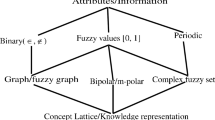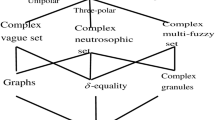Abstract
Recently, the properties of complex fuzzy concept lattice given a way to represent the uncertainty and its fluctuation. It given a well established mathematical model for understanding the dark data sets with respect to phase of time. The complex graphical structure visualization given a way to discover some of the useful pattern for decision making process. The problem arises when large number of complex fuzzy concepts are generated from the given context. To resolve this issue, a method is proposed for generating the complex fuzzy concepts based on maximal acceptance of complex fuzzy attributes (or objects) at given period of time. The information content is measured on Shannon entropy for the given phase of time. Thereafter, the complex fuzzy concepts are reduced based on their computed weight at different granulation to control the information pollution with an illustrative example. The obtained results are compared with recently available approaches on complex fuzzy concept lattice.







Similar content being viewed by others
References
Ali M, Smarandache F (2017) Complex neutrosophic set. Neural Comput Application 28:1817–1834
Alkouri AUM, Salleh AR (2014) Linguistic variables, hedges and several distances on complex fuzzy sets. J. Intell. Fuzzy Syst. 26:2527–2535
Alkouri AUM, Salleh AR (2014) Complex fuzzy soft multisets. The 2014 UKM FST Postgraduate Colloquium, In: Proceddings of 2014 AIP conference, 1614:955–961. https://doi.org/10.1063/1.4895330.
Alkouri AUM, Oqla MM, Mabruka A (2020) On bipolar complex fuzzy sets and its application. Journal of Intelligent & Fuzzy Systems 39(1):383–397
Akram M, Kahraman C, Zahida K (2021) Group decision-making based on complex spherical fuzzy VIKOR approach. Knowledge-Based Systems 216:106793
Bal M, Singh PK, Katy DA (2022) A short introduction to the symbolic Turiyam vector spaces and complex numbers. Journal of Neutrosophic and Fuzzy Systems 2(1):76–87. https://doi.org/10.54216/JNFS.020107
Bi L, Zeng Z, Hu B, Dai S (2019) Two classes of entropy measures for complex fuzzy sets. Mathematics 7(1):96 https://doi.org/10.3390/math7010096
Birkhoff G (1940) Lattice Theory. Amer. Math. Soc. Coll. Pub. 25:1–418
Burusco A, Fuentes-Gonzales R (1994) The study of L-fuzzy concept lattice. Matheware and Soft Computing 3:209–218
B\(\check{e}\)lohl\(\acute{a}\)vek R, Sklen \(\acute{a} \check{r}\) V, Zacpal J (2005) Crisply generated fuzzy concepts. In: Proceedings of ICFCA 2005, Lecture Notes in Computer Science 3403, pp. 269–284
Buckley JJ (1989) Fuzzy complex numbers. Fuzzy Sets and Systems 33(3):333–345
Georg C (1874) Ueber eine Eigenschaft des Inbegriffes aller reellen algebraischen Zahlen. Journal für die Reine und Angewandte Mathematik 77:258–262. https://doi.org/10.1515/crll.1874.77.258
Dick S (2005) Toward complex fuzzy logic. IEEE Trans. Fuzzy Syst. 13(3):405–414
Ganter B, Wille R (1999) Formal Concept Analysis: Mathematical Foundation. Springer-Verlag, Berlin
Ghosh P, Kundu K, Sarkar D (2010) Fuzzy graph representation of a fuzzy concept lattice. Fuzzy Sets and Systems 161:1669–1675
Goguen JA (1967) L-fuzzy sets. J. Math. Anal. Appl. 18:145–174
Gong Z, Xiao Z (2020) Fuzzy complex numbers: Representations, operations, and their analysis. Fuzzy Sets and Systems 417:1–45
Guo W, Bi L, Hu B, Dai S (2020) Cosine similarity measure of complex fuzzy sets and robustness of complex fuzzy connectives. Article ID 6716819. https://doi.org/10.1155/2020/6716819
Jafari S, Sprott JC, Golpayegani SMRH (2016) Layla and Majnun: a complex love story. Nonlinear Dyn 83:615–622. https://doi.org/10.1007/s11071-015-2351-3
Krídlo O, Ojeda–Aciego M (2018) Formal concept analysis and structures underlying quantum logics. In: Medina J. et al. (eds) Information Processing and Management of Uncertainty in Knowledge–Based Systems. Theory and Foundations. IPMU 2018. Communications in Computer and Information Science, Springer, Cham, 853: 574–584
Li C, Chan FT (2012) Knowledge discovery by an intelligent approach using complex fuzzy sets. Lect. Notes Comput. Sci. 7196:320–329
Li C, Tu CH (2019) Complex neural fuzzy system and its application on multi-class prediction – A novel approach using complex fuzzy sets, IIM and multi-swarm learning. Applied Soft Computing 84:105735
Li JH, Mei C, Xu X, Qian Y (2015) Concept learning via granular computing: A cognitive viewpoint. Information Sciences 298:447–467
Li J, He Z, Zhu Q (2013) An Entropy-based weighted concept lattice for merging multi-source geo-ontologies. Entropy 15(201):2303–2318
Liu P, Ali Z, Mahmood T (2020) distance measures and cross-entropy based on complex fuzzy sets and their application in decision making. Journal of Intelligent & Fuzzy Systems 39(3):3351–3374
Lindig C (2000) Fast concept analysis. In: Ganter, B., Mineau, G.W. (eds.) ICCS 2000. LNCS, vol. 1867, pp. 152–161
Ma X, Zhan J, Khan M, Zeeshan M, Anis S, Awan AS (2019) Complex fuzzy sets with applications in signals. Computational and Applied Mathematics 38(150). https://doi.org/10.1007/s40314-019-0925-2
Medina J (2012) Relating attribute reduction in formal, object-oriented and property-oriented concept lattices. Computers and Mathematics with Applications 208:95–110
OreOre Ø (1944) Galois Connexions. Transactions of the American Mathematical Society 55(3):493–513. https://doi.org/10.2307/1990305
Ngan RT, Son LH, Ali M, Tamir DE, Rishe ND, Kandel A (2020) Representing complex intuitionistic fuzzy set by quaternion numbers and applications to decision making. Applied Soft Computing 87:105961
Nguyen HT, Kandel A, Kreinovich V (2000) Complex fuzzy sets: towards new foundations. FUZZ-IEEE 2000:1045–1048
Pocs J (2012) Note on generating fuzzy concept lattices via Galois connections. Information Sciences 185(1):128–136
Pedrycz W (2001), Granular computing: an introduction. In: Proceedings Joint 9th IFSA World Congress and 20th NAFIPS International Conference, Canada 3(2001)1349–1354
Qudah YA, Hassan N (2017) Operations on complex multi-fuzzy sets. Journal of Intelligent & Fuzzy Systems 33(3):1527–1540. https://doi.org/10.3233/JIFS-162428
Ramot D, Milo R, Friedman M, Kandel A (2002) Complex fuzzy sets. IEEE Trans. Fuzzy Syst. 10(2):171–186
Ramot D, Friedman M, Langholz G, Kandel A (2003) Complex fuzzy logic. IEEE Trans. Fuzzy Syst. 11(4):450–461
Shannon CE (1948) A mathematical theory of communication. The Bell System Technical Journal 27(379–423):623–656
Sumangali K, Kumar Ch Aswani, Li JH (2017) Concept Compression in Formal Concept Analysis Using Entropy-Based Attribute Priority. Applied Artificial Intelligence 31(3):251–278
Sethi N, Das SK, Panda DC (2012) Probabilistic Interpretation of complex fuzzy set. International Journal of Computer Science, Engineering and Information Technology 2(2):31–44
Selvachandran G, Maji PK, Abed IE, Salleh AR (2016) Complex vague soft sets and its distance measures. Journal of Intelligent and Fuzzy Systems 31:55–68
Selvachandran G, Singh PK (2018) Interval-valued complex fuzzy soft set and its application. International Journal for Uncertainty Quantification 8(2):101–117
Selvachandran G, Garg H, Quek SG (2018) Vague Entropy Measure for Complex Vague Soft Set. Entropy 20(403); https://doi.org/10.3390/e20060403
Selvachandran G, Quek SG, Son LH et al (2021) (2021) Relations and compositions between interval-valued complex fuzzy sets and applications for analysis of customers’ online shopping preferences and behavior. Applied Soft Computing. https://doi.org/10.1016/j.asoc.2021.108082
Singh PK, Gani A (2015) Fuzzy concept lattice reduction using Shannon entropy and Huffman coding. Journal of Applied Non-Classic logic 25(2):101–119
Singh PK, Aswani Kumar Ch, Li JH (2017) Concept reduction in formal concept analysis with fuzzy setting using Shannon entropy. International Journal of Machine Learning and Cybernetics 8(1):179–189
Singh PK (2017) Complex vague set based concept lattice. Chaos, Solitons & Fractals 95:145–153
Singh PK (2018) Complex neutrosophic concept lattice and its applications to Air quality analysis. Chaos, Solitons and Fractals 109:206–213
Singh PK, Selvachandra G, Aswani Kumar Ch (2018) Interval-valued complex fuzzy concept lattice and its granular decomposition. Advances in Intelligent Systems and Computing 740:275–283
Singh PK (2019) Complex fuzzy concept lattice. Neural Processing Letters 49(3):1511–1526
Singh PK (2019) Granular based decomposition of complex fuzzy context and its analysis. Progress in Artificial Intelligence 8(2):181–193
Singh PK (2019) Object and attribute oriented m-polar fuzzy concept lattice using the projection operator. Granular Computing 4(3):545–558. https://doi.org/10.1007/s41066-018-0117-2
Singh PK (2020) Complex vague contexts analysis using Cartesian products and granulation. Granular Computing 5(1):37–53
Singh PK (2020) Bipolar \(\delta \)-equal complex fuzzy concept lattice with its application. Neural Computing and Applications 32:2405–2422
Singh PK (2021) Complex multi-fuzzy context analysis at different granulation. Granular Computing 6(1):191–206
Singh PK (2021) Complex neutrosophic \(\delta \)-equal concepts and their applications in water healthcare. Data Analytics in Biomedical Engineering and Healthcare, Elsevier 2021:233–267. https://doi.org/10.1016/B978-0-12-819314-3.00015-X
Singh PK (2021) Dark data analysis using Intuitionistic Plithogenic Graphs. International Journal of Neutrosophic Sciences 16(2):80–100. https://doi.org/10.54216/IJNS.160204
Singh PK (2022) Complex Plithogenic Set. International Journal of Neutrosophic Sciences 18(1):57–72. https://doi.org/10.54216/IJNS.180106
Tamir DE, Kandel A (2011) Axiomatic theory of complex fuzzy logic and complex fuzzy classes. Intenational Journal of Computers, Communications & Control 6(3):562–576
Tamir DE, Rishe ND, Kandel A (2015) Complex fuzzy sets and complex fuzzy logic: an overview of theory and applications. Springer International Publishing, Cham, Switzerland, Fifty years of fuzzy logic and its applications, pp 661–681
Thirunavukarasu P, Suresh R, Viswanathan KK (2016) Energy of a complex fuzzy graph. International J. of Math. Sci. & Engg. Appls. (IJMSEA) 10(1):243–248
Ward M, Dilworth RP (1939) Residuated lattices. Trans. Amer. Math. Soc. 45:335–354
Wolff KE (2002) Concepts in fuzzy scaling theory: order and granularity. Fuzzy Sets and Systems 132:63–75
Wu W, Leung Y, Mi J (2009) Granular computing and knowledge reduction in formal contexts. IEEE Trans Knowledge Data Engineering 21:1461–1474
Wille R (1982) Restructuring lattice theory: an approach based on hierarchies of concepts. In: Rival I (ed) Ordered Sets, Reidel Dordrect–Boston, pp. 445–470
Yazdanbakhsh O, Dick S (2018) A Systematic review of complex fuzzy sets and logic. Fuzzy Sets and Systems 338:1–22
Zadeh LA (1965) Fuzzy Sets. Information and Control 8(3):338–353
Zadeh LA (1975) The concept of a linguistic variable and its application to approximate reasoning-I. Information Sciences 8:199–249
Zhao ZQ, Ma SQ (2016) Complex fuzzy matrix and its convergence problem research. In: Cao B-Y et al (eds) Fuzzy Systems & Operations Research and Management. Springer International, Cham, Switzerland, pp 157–162
Zhang G, Dillon TS, Cai KY, Ma J, Lu J (2009) Operation properties and \(\delta \)-equalities of complex fuzzy sets. Int. J. Approx. Reason. 50:1227–1249
Zhu K, Wang J, Yang Y (2019) On two new classes of stabilizers in residuated lattices. Soft Comput 23:12209–12219
Acknowledgements
Author obliged for the time and suggestions given by reviewers and editor.
Funding
Author declares that, there is no funding for this paper.
Author information
Authors and Affiliations
Corresponding author
Ethics declarations
Conflict of Interest
Author declares that, there is no conflict of interest for this paper.
Ethical approval
This article does not contain any studies with human participants or animals.
Additional information
Publisher's Note
Springer Nature remains neutral with regard to jurisdictional claims in published maps and institutional affiliations.
Appendix
Appendix
Nomenclature | Meaning |
|---|---|
K | Formal fuzzy context |
K | Complex fuzzy context |
L | Scale of truth degree |
X | Set of objects |
\(x_i\) | i th–object |
Y | Set of fuzzy attributes |
\({\tilde{Y}}\) | Set of complex fuzzy attributes |
\(y_j\) | j th–attribute |
R | L–relation between X and R |
\({\tilde{R}}\) | Complex fuzzy relation between X and R |
r | Amplitude of complex fuzzy set in [0, 1] |
\(\theta \) | Phase term of complex fuzzy set in \([0, \pi ]\) |
P | Complex fuzzy Probability |
Z | Complex fuzzy set |
\(\mu _z\) | Membership–values of complex fuzzy element \(z \in Z\) |
\(p_{i}\) | i th–Object Probability |
(\(\uparrow , \downarrow \)) | Galois connection |
A | Extent |
B | Intent |
\(\bigcup \) | Union |
\(\bigcap \) | Intersection |
\(\wedge \) | Infimum |
\(\vee \) | Supremum |
\(\alpha \) | Granulation |
E | Average information weight |
\(\sum \) | Summation |
m | Total number of complex fuzzy attributes |
n | Total number of complex fuzzy objects |
\(w_{j}\) | Weight of attribute |
\(W_{j}\) | Weight of j–th concept |
\(\textit{CFC}_\mathbf{{F} }\) | Set of complex fuzzy concepts |
V | Vertex of complex fuzzy set |
\(\mu _c\) | Complex membership of vertex |
\(\rho _c\) | Complex membership of edges |
Rights and permissions
About this article
Cite this article
Singh, P.K. Crisply Generated Complex Fuzzy Concepts Analysis Using Shannon Entropy. Neural Process Lett 54, 5643–5667 (2022). https://doi.org/10.1007/s11063-022-10878-7
Accepted:
Published:
Issue Date:
DOI: https://doi.org/10.1007/s11063-022-10878-7




